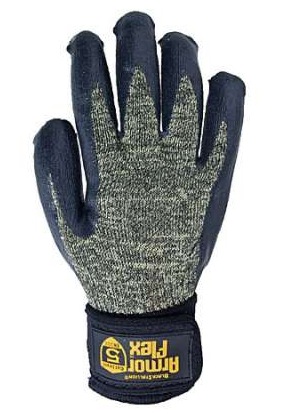It might not be as commonplace as the debate over Metric System or English System, or as fun as Boxers or Briefs, but if you wear safety gloves in your line of work, it’s certainly no less important. Glove Cut Level Ratings are something you just plain have to pay attention to. And it’s important to know how to protect your hands with the correct safety gloves.
There are two different rating methods for glove cut resistance: the EN (European standard) or ASTM. If your company is looking to implement a cut-resistant glove program, or improve an existing one, the ASTM method is the better choice. It is more representative of workplace conditions than the EN method.
The EN test method is not as accurate in determining risk protection that workers are exposed to in industrial workplaces, where the chance of suffering a cut exists. When gloves are tested, the pressure applied to the blade in the lab test is simply too low, and the alternating displacement of the blade makes the contact time with the glove very short – simply too short to give an accurate estimation.
This problem is magnified when it comes to gloves made out of high cut-resistant materials. Because of the numerous alternating movements required to cut the sample, the highly-resistant fabric quickly dulls the test blade, and this leads to results that are overestimated.
The ASTM method is more accurate because it is more representative of real workplace conditions than the EN method. Instead of using numerous alternating movements, the straight blade cuts the test fabric in a single stroke. It is done this way because, in the course of a workday, the risk of laceration is much more common this way, such as from a sharp edge like a knife or a box cutter. In addition, various weight loads are applied in the testing process as it travels across the test fabric, which is more realistic and reflective of real working conditions and hazards. You should also be conscious of knowing which gloves fit you best. Without the best fit possible you still run the risk of injury due to lack of coverage or slippage from wearing wrongly sized gloves.
It should be pointed out that both of these testing methods have their limitations, because of both use control weight, not sudden force, which is very often the hazard encountered in the workplace.
The EN 388 cut resistant standard for gloves has five different levels of cut resistance, with Level 1 being the least cut-resistant, and Level 5 being the most cut-resistant.
The ASTM system has six different levels of cut resistance, with Level 0 (less than 199 grams of weight per inch of blade travel) as the least cut-resistant, and Level 5 (more than 3500 grams of weight per inch of blade travel) as the most cut-resistant. Level 1 and Level 2 are considered moderate/standard protection levels, according to ANSI/ISEA cut standards. These are woven gloves, so they are more breathable than others, but are only recommended for use in situations where the objects being handled are only mildly abrasive, such as a safety knife or untrimmed sheet metal. Levels 3-5 are considered heavy duty/ high-performance protection levels, according to ANSI/ISEA cut standards. Instead of being woven, these are coated or multi-layered gloves, and as such, have a higher cut-resistance and longer lifespan. They are recommended for use in the handling of heavy and rough, sharp-edged objects or are highly abrasive.
Finding the perfect pair of safety gloves is important to help keep yourself protected while working with hazardous materials. WorkingPerson.com offers a wide selection of safety gloves including cut resistant gloves, welding gloves, and high visibility gloves.




